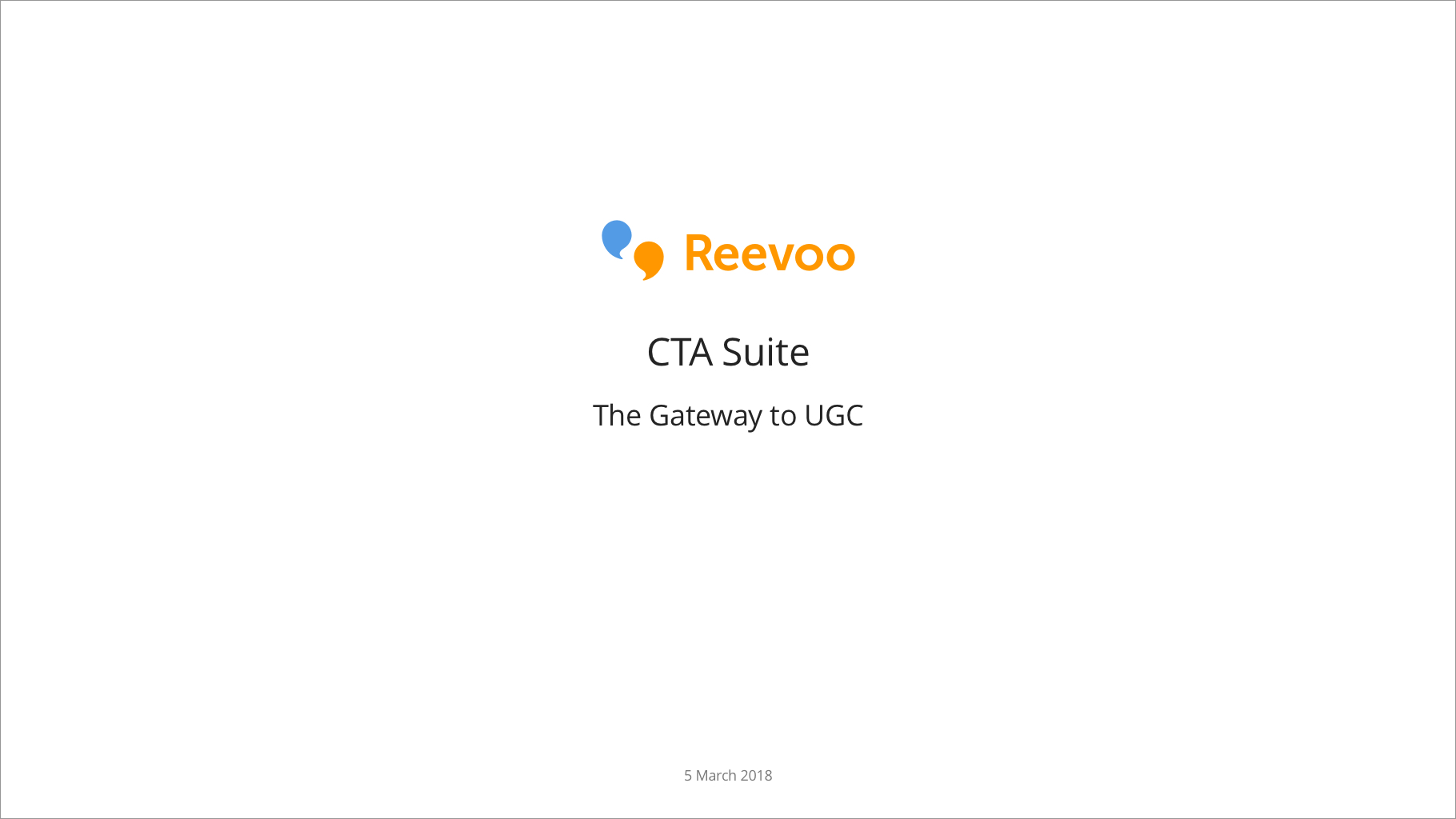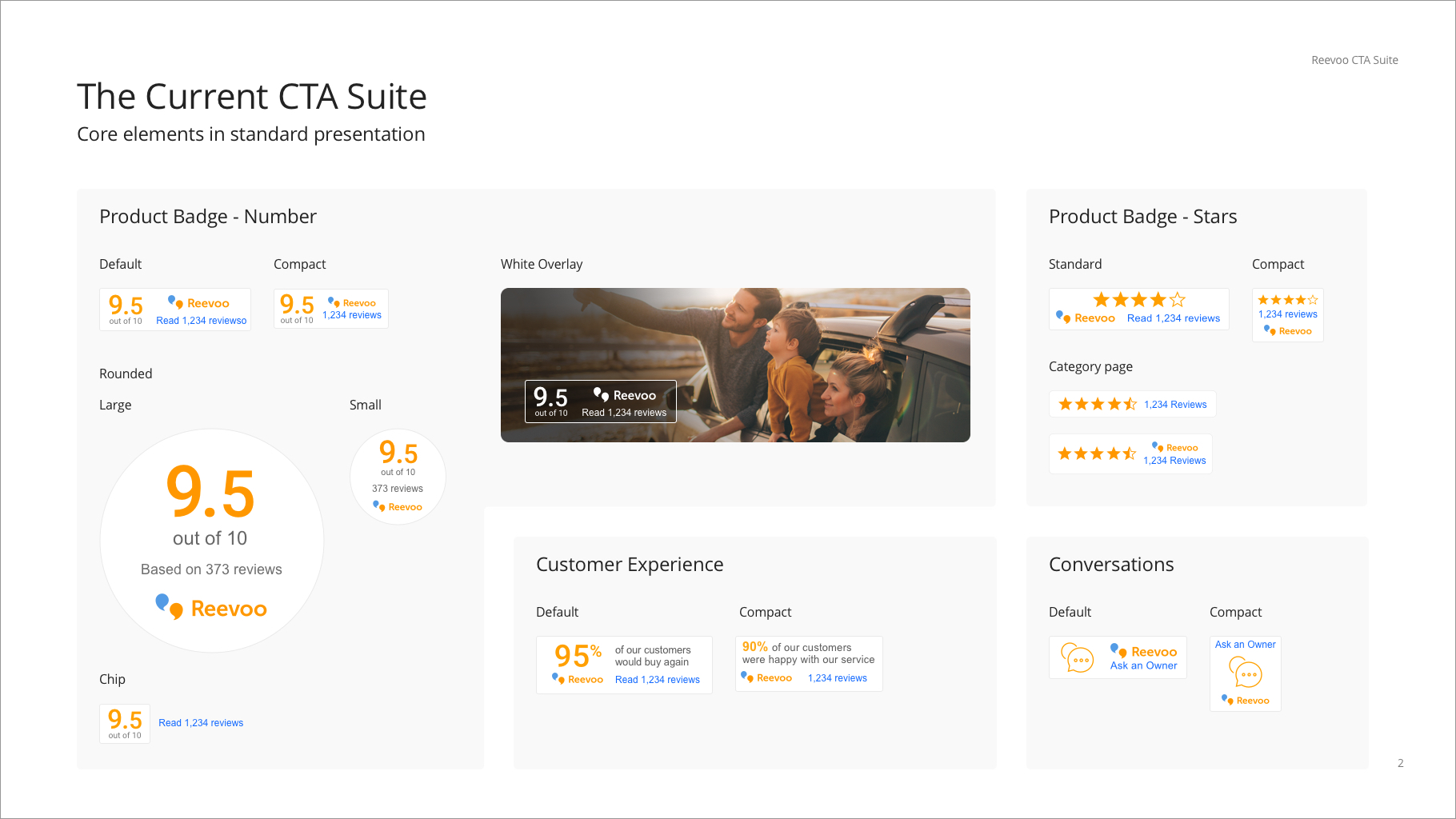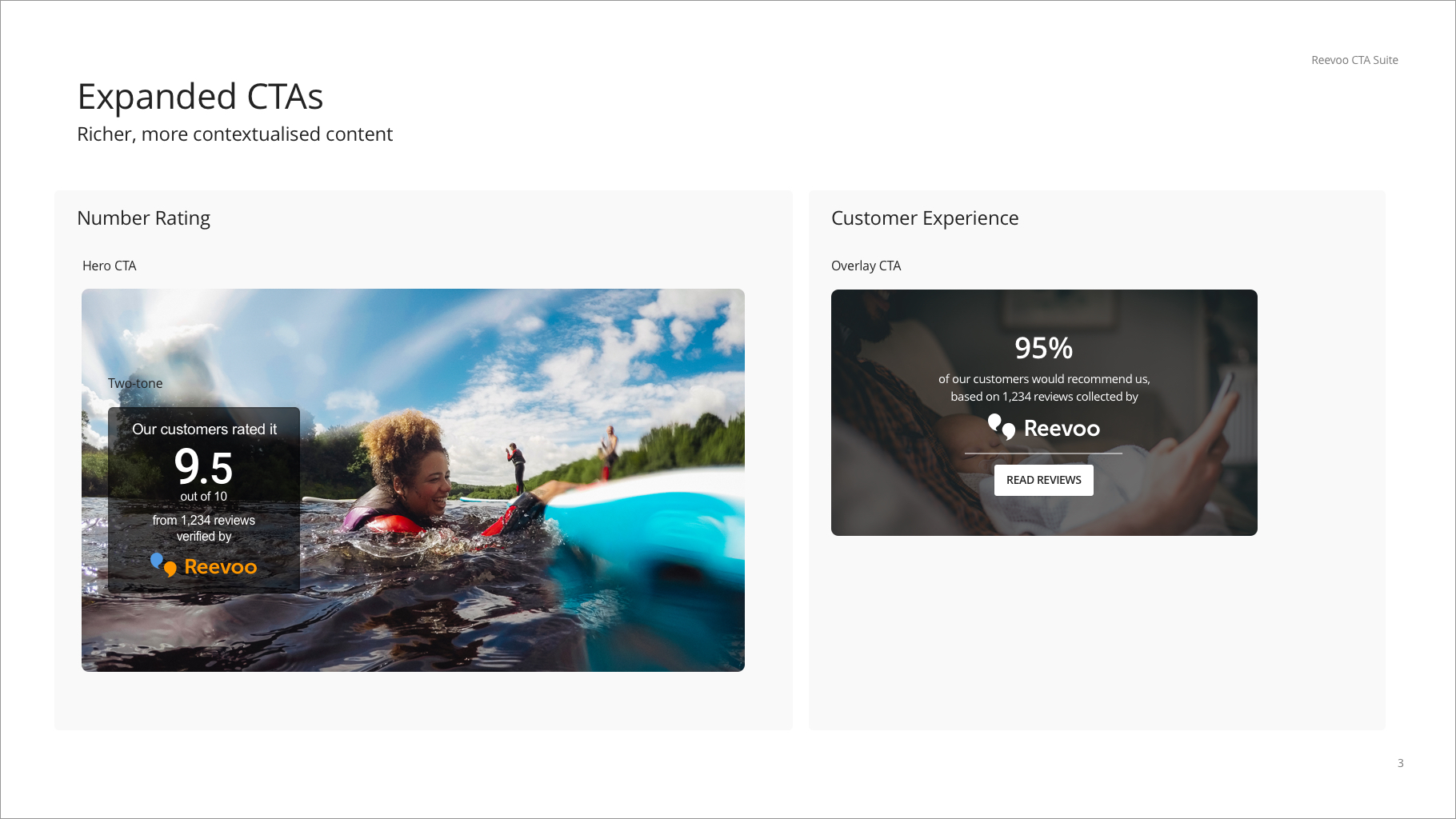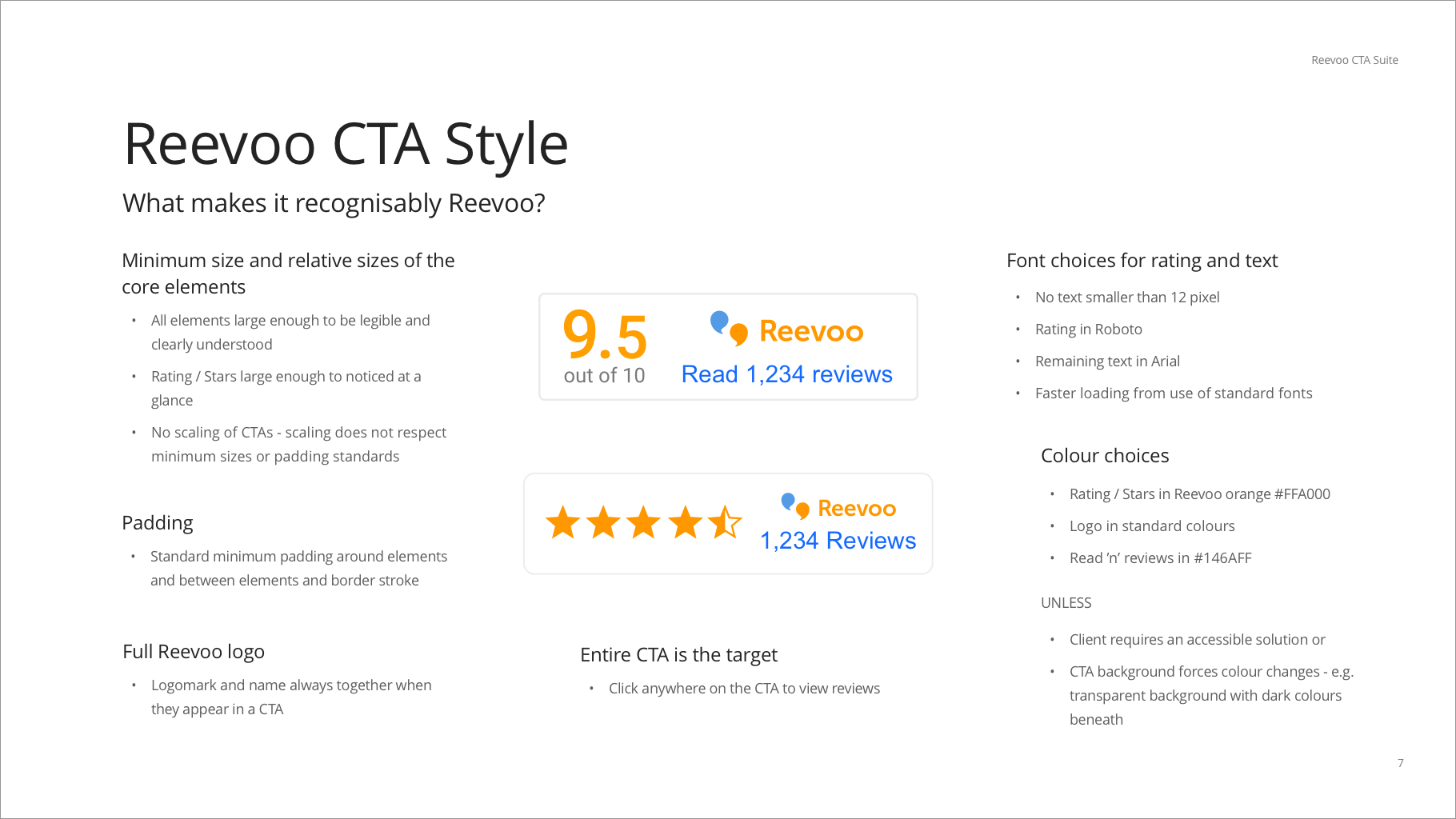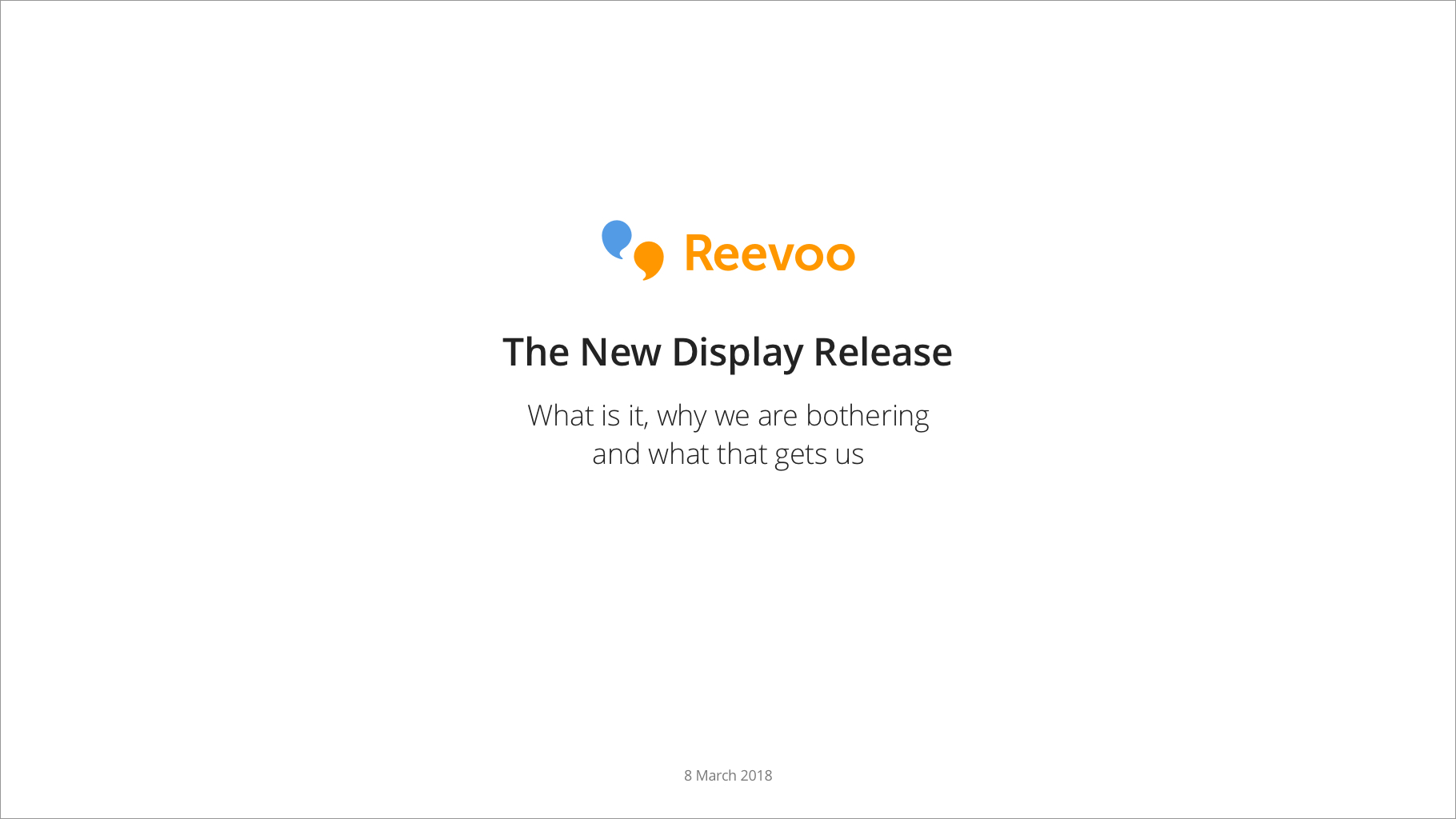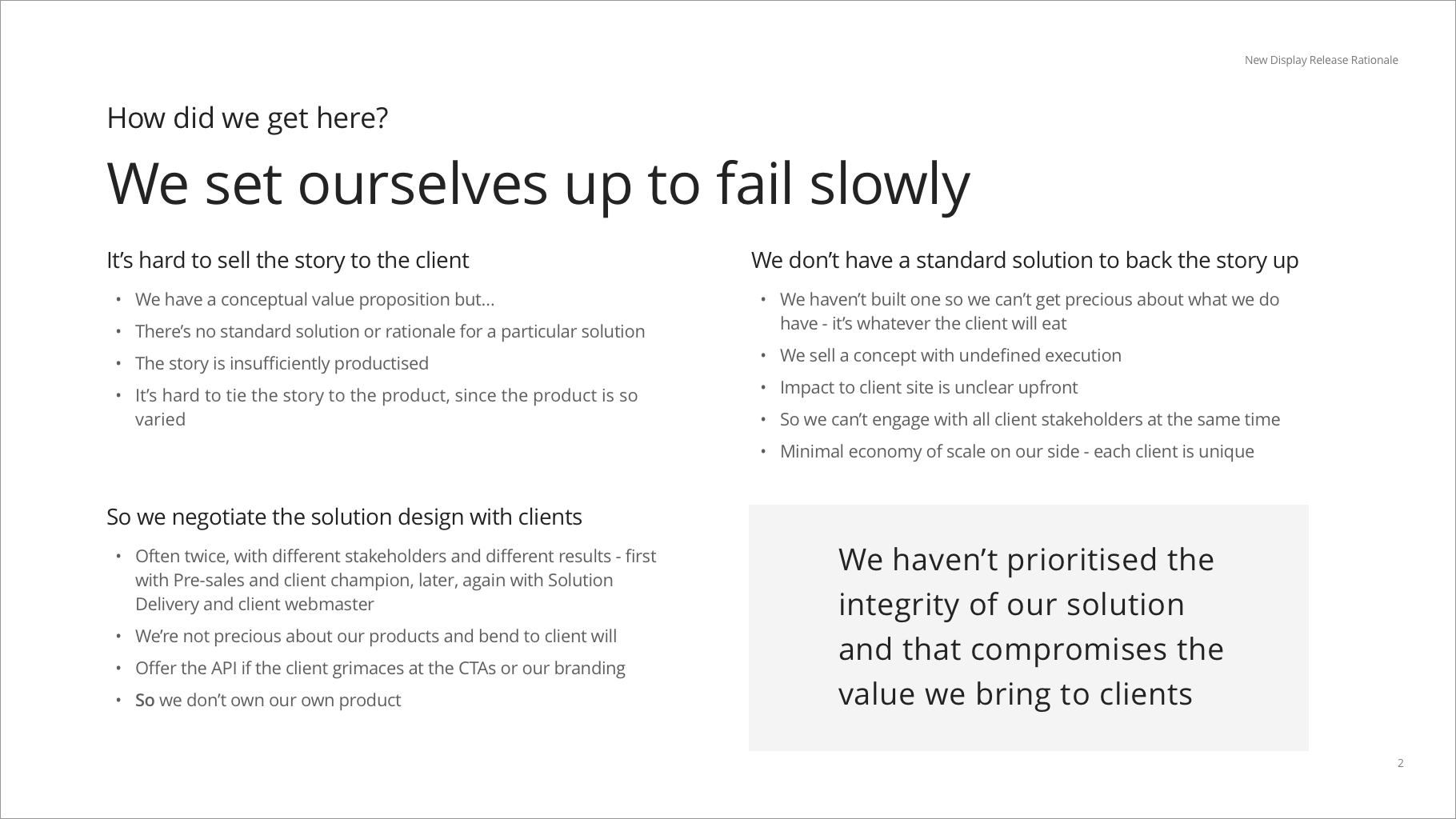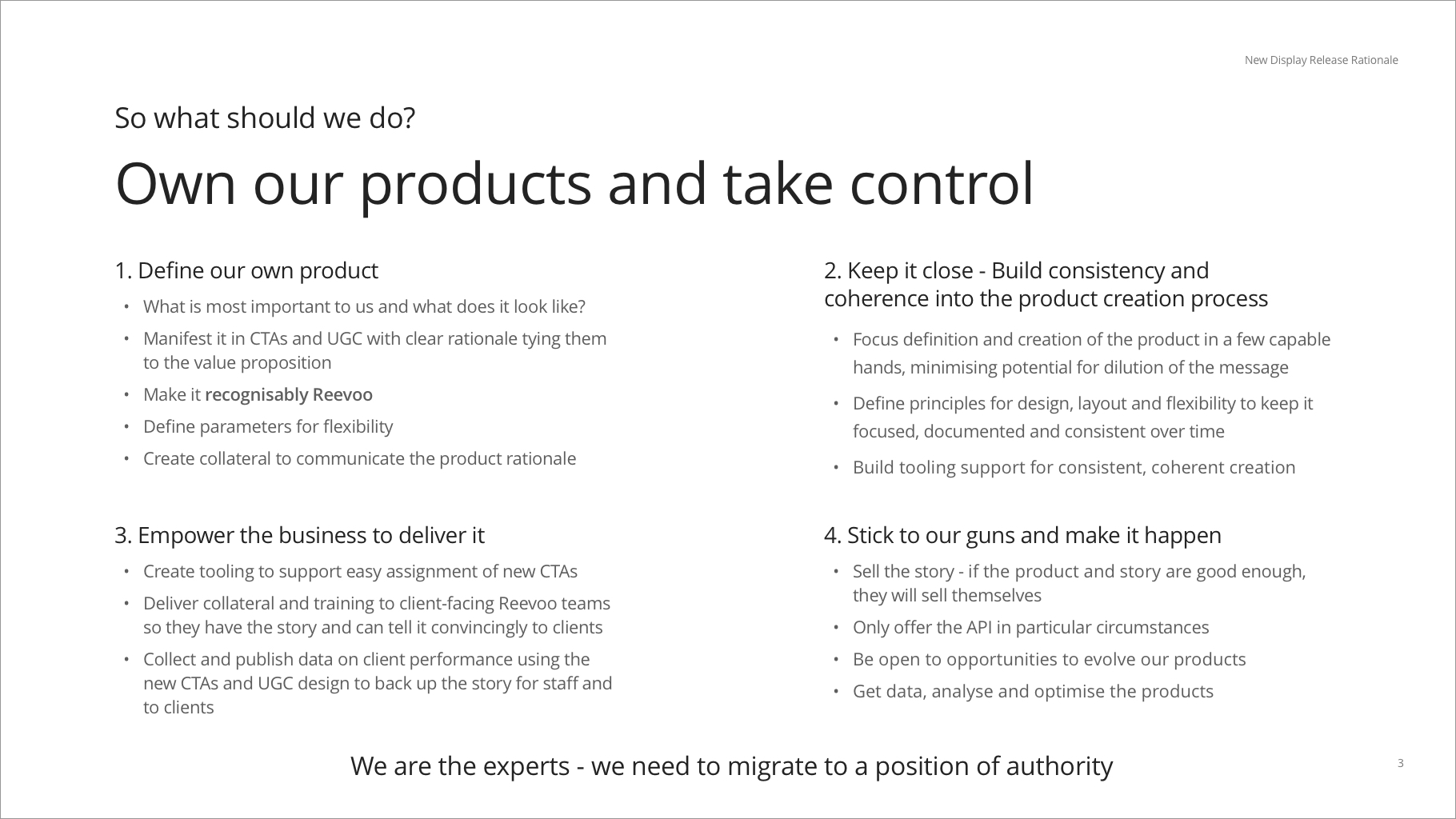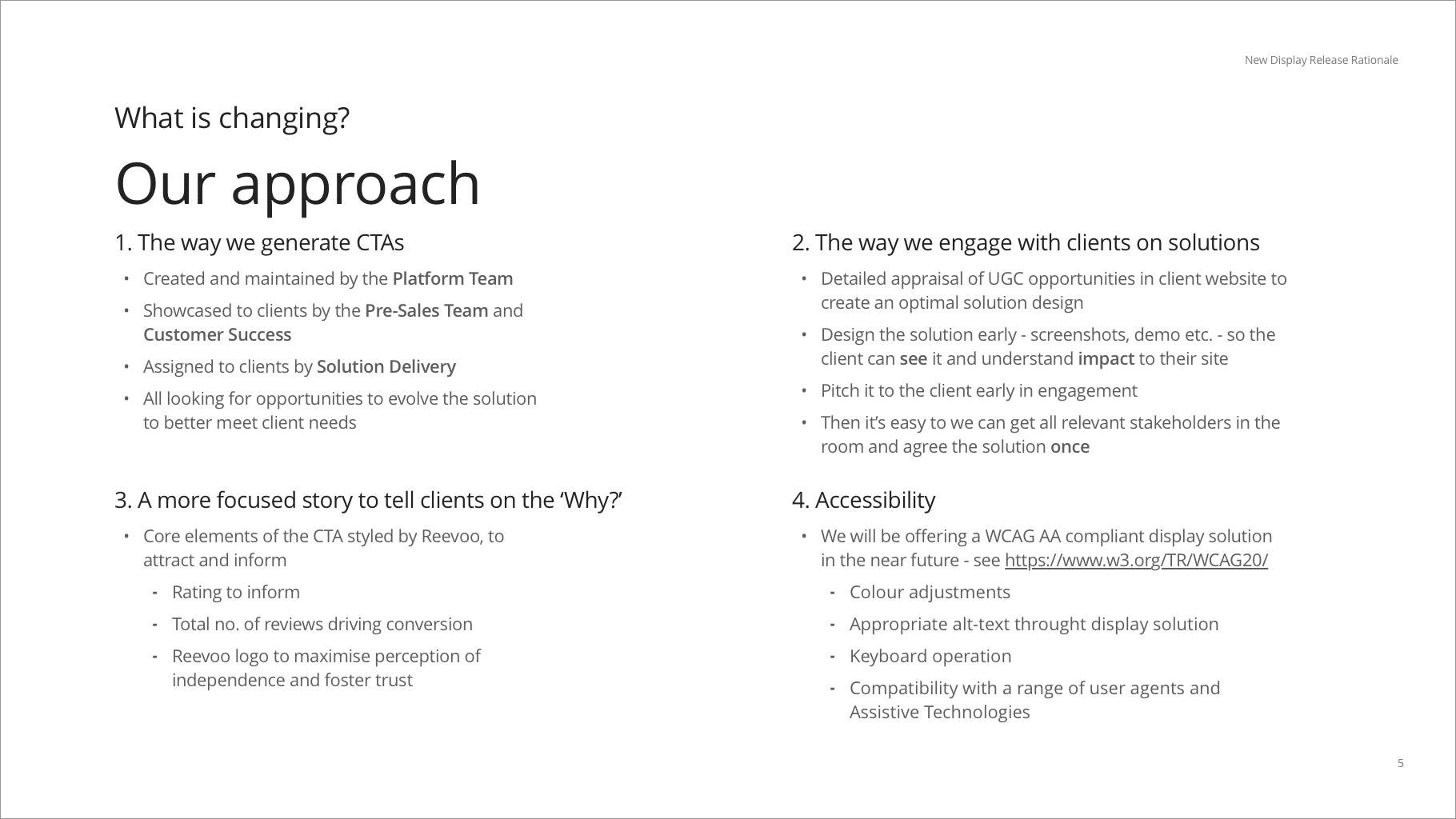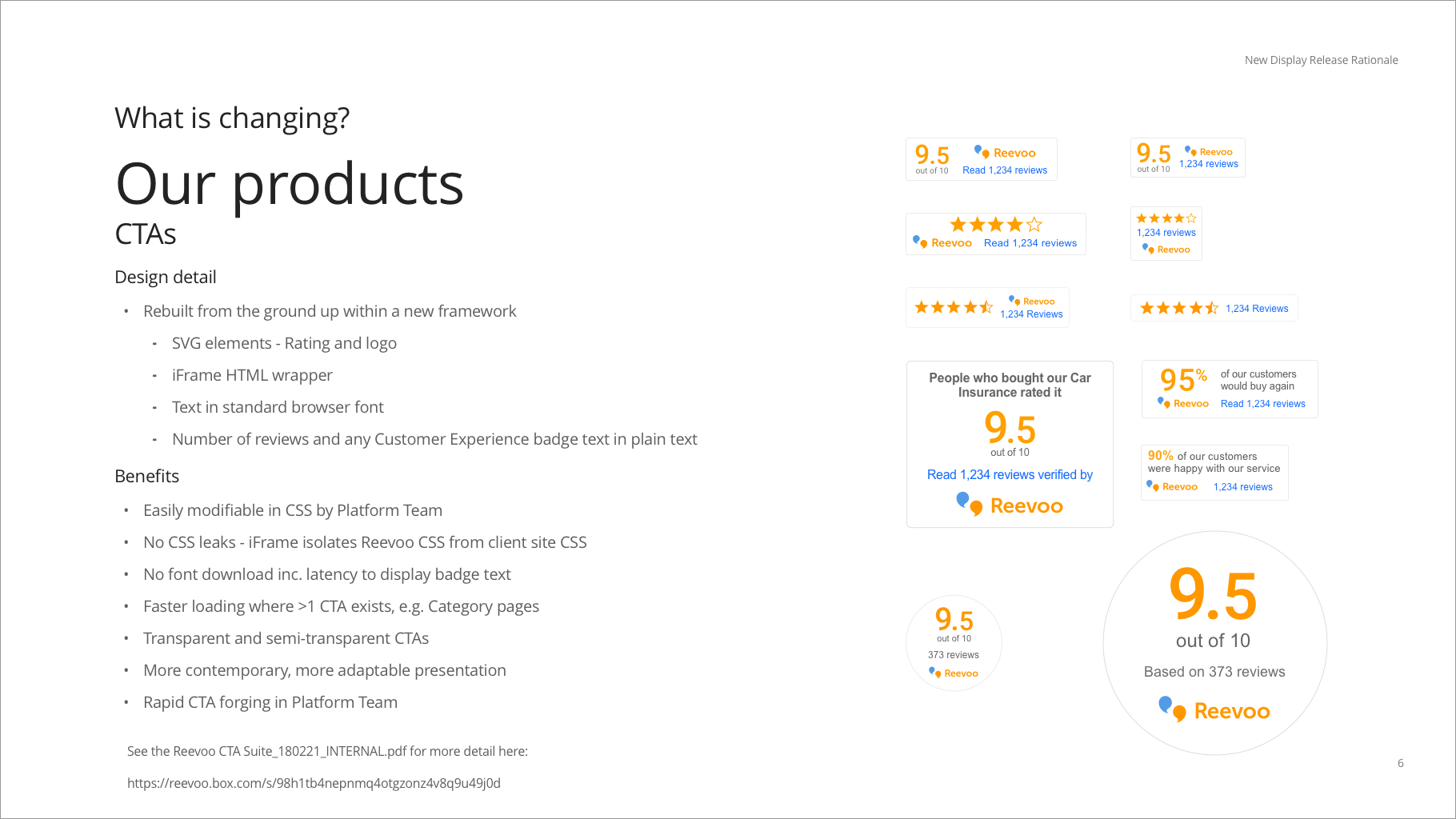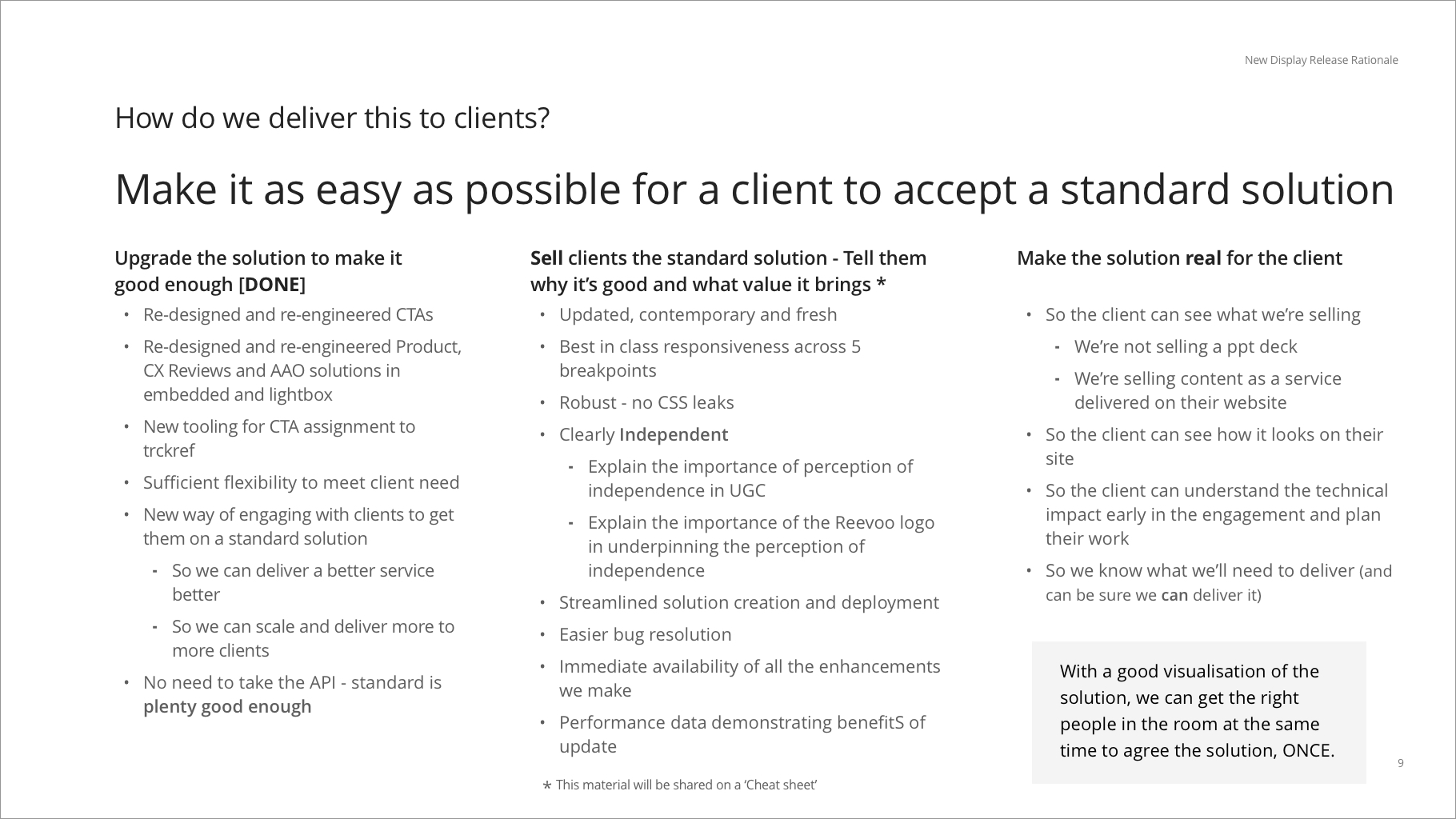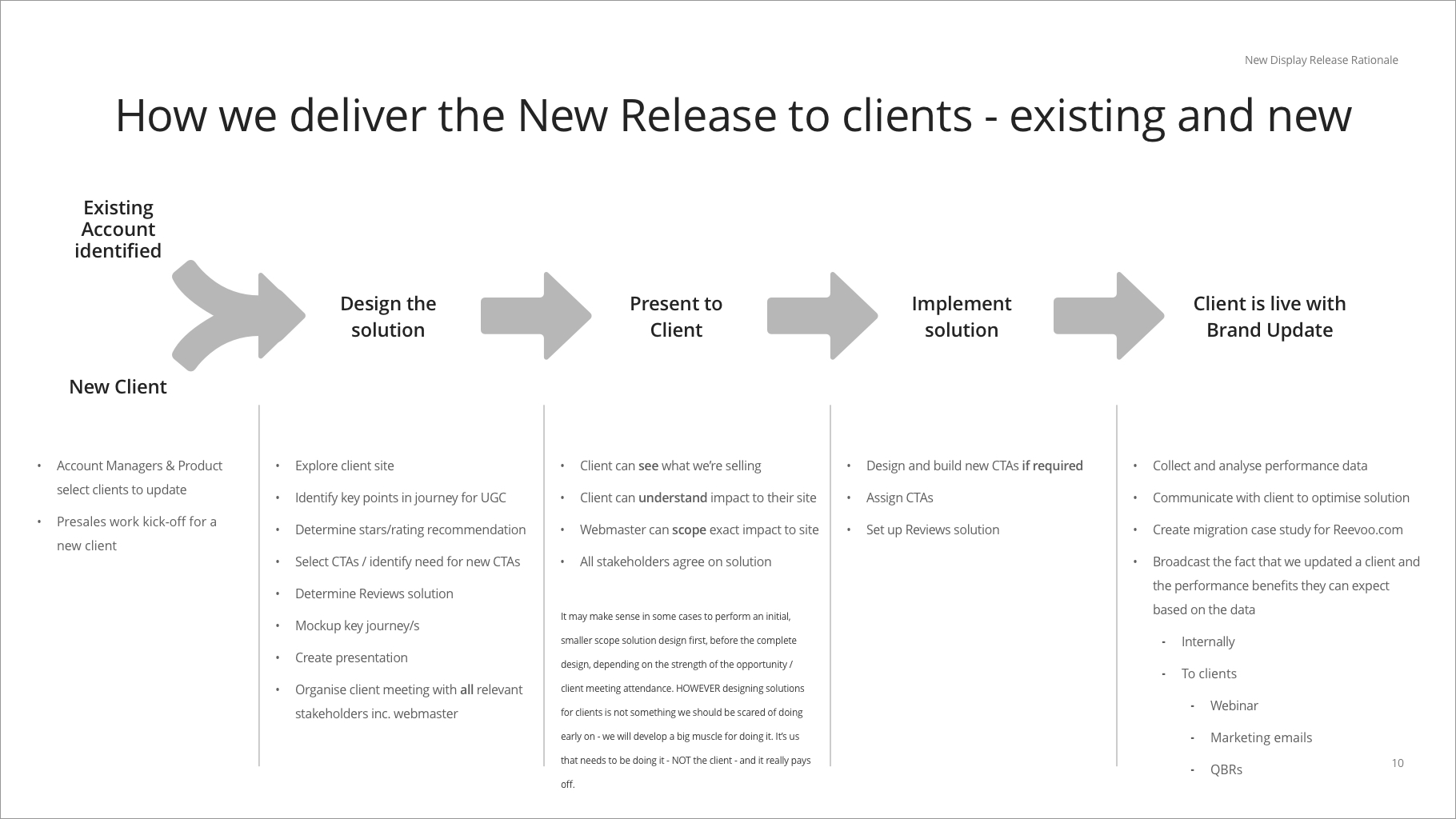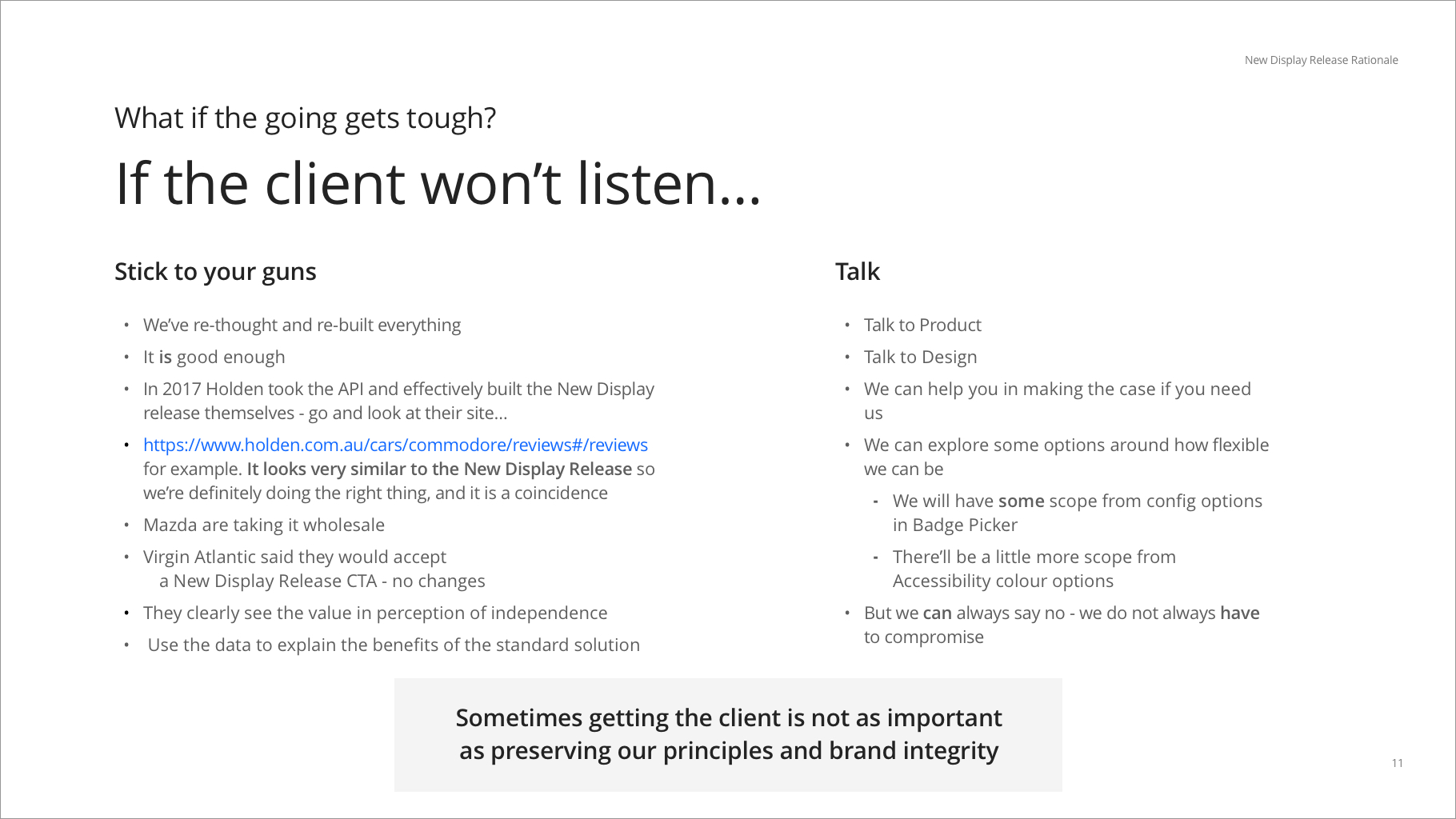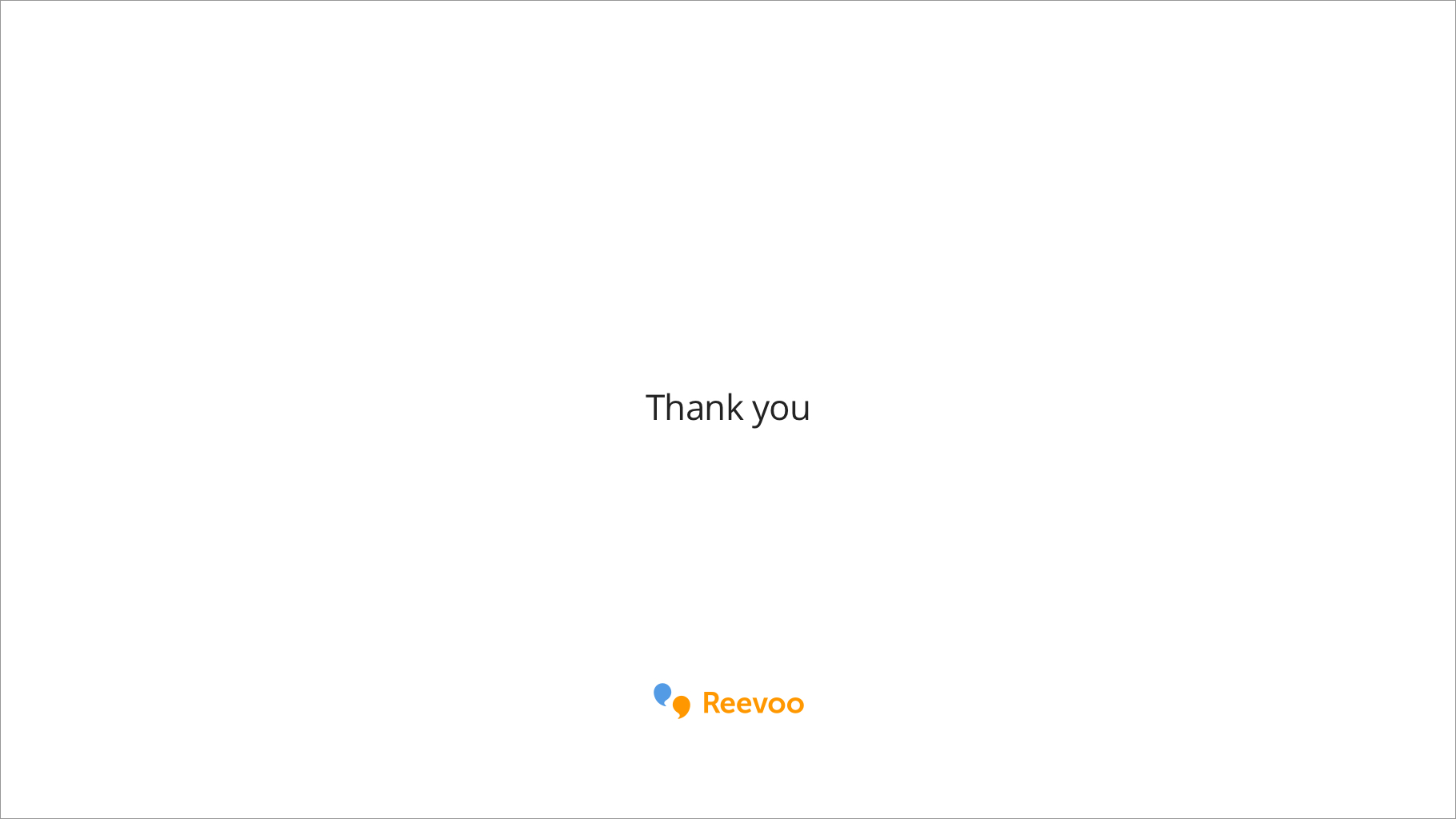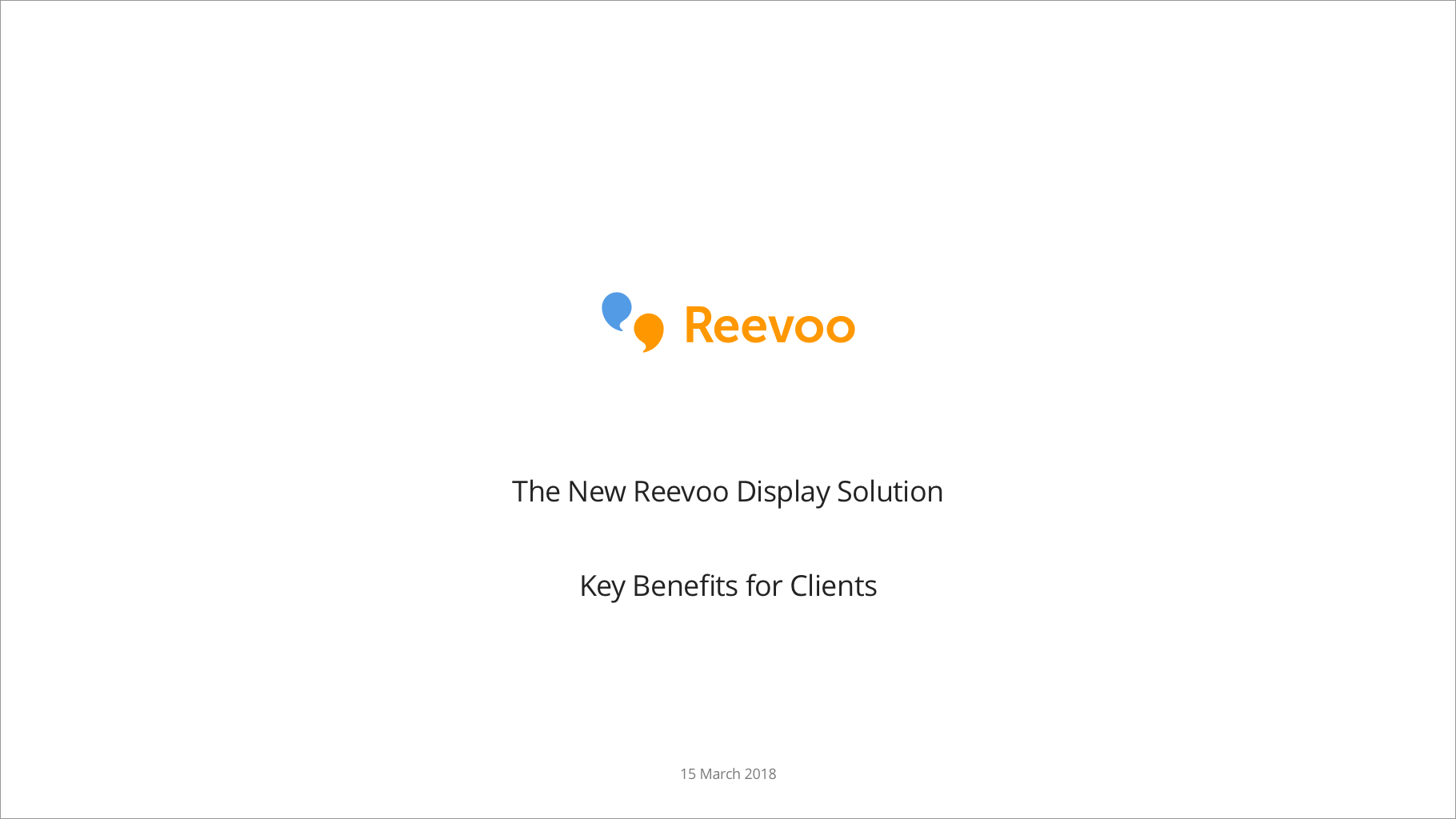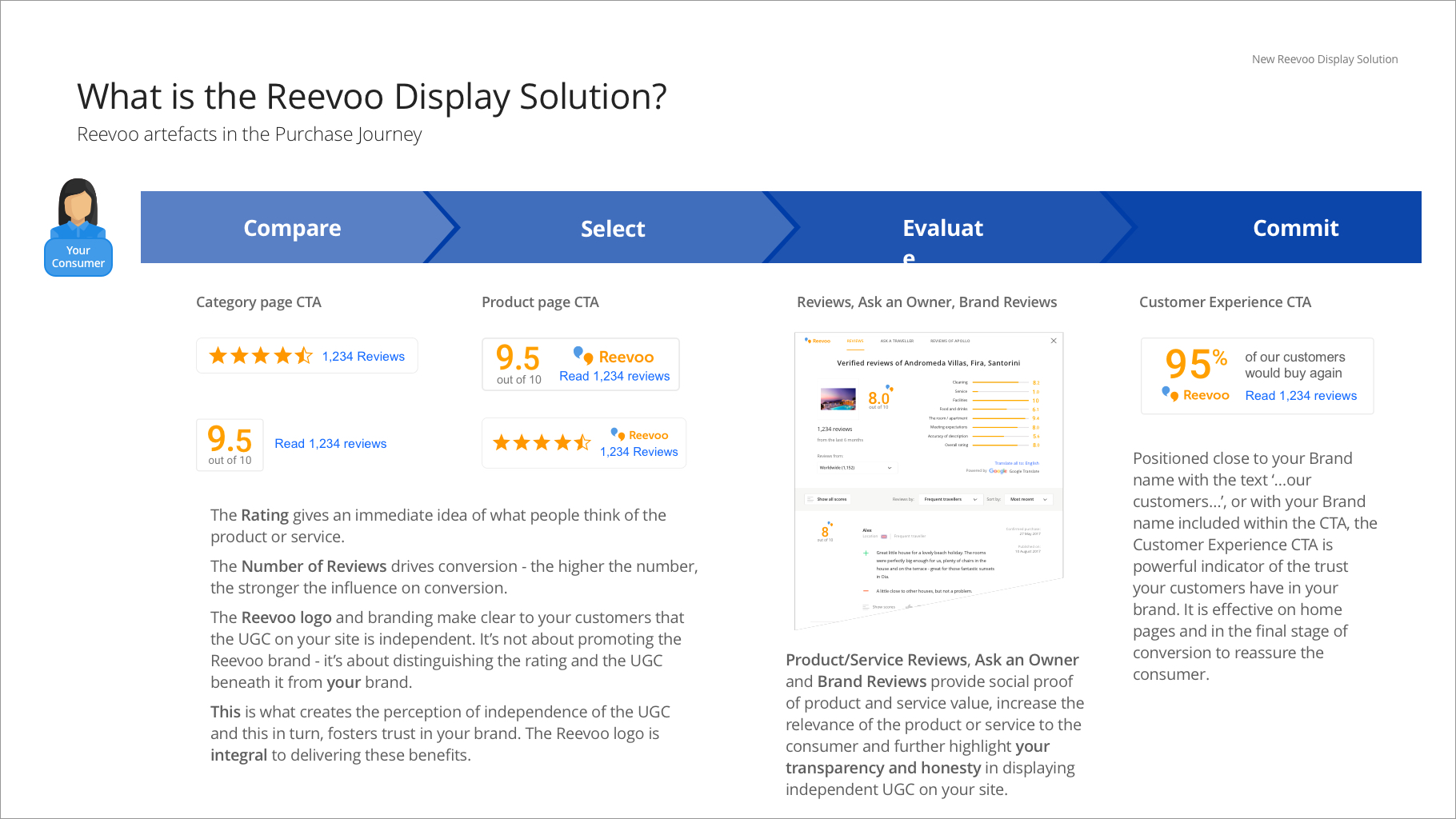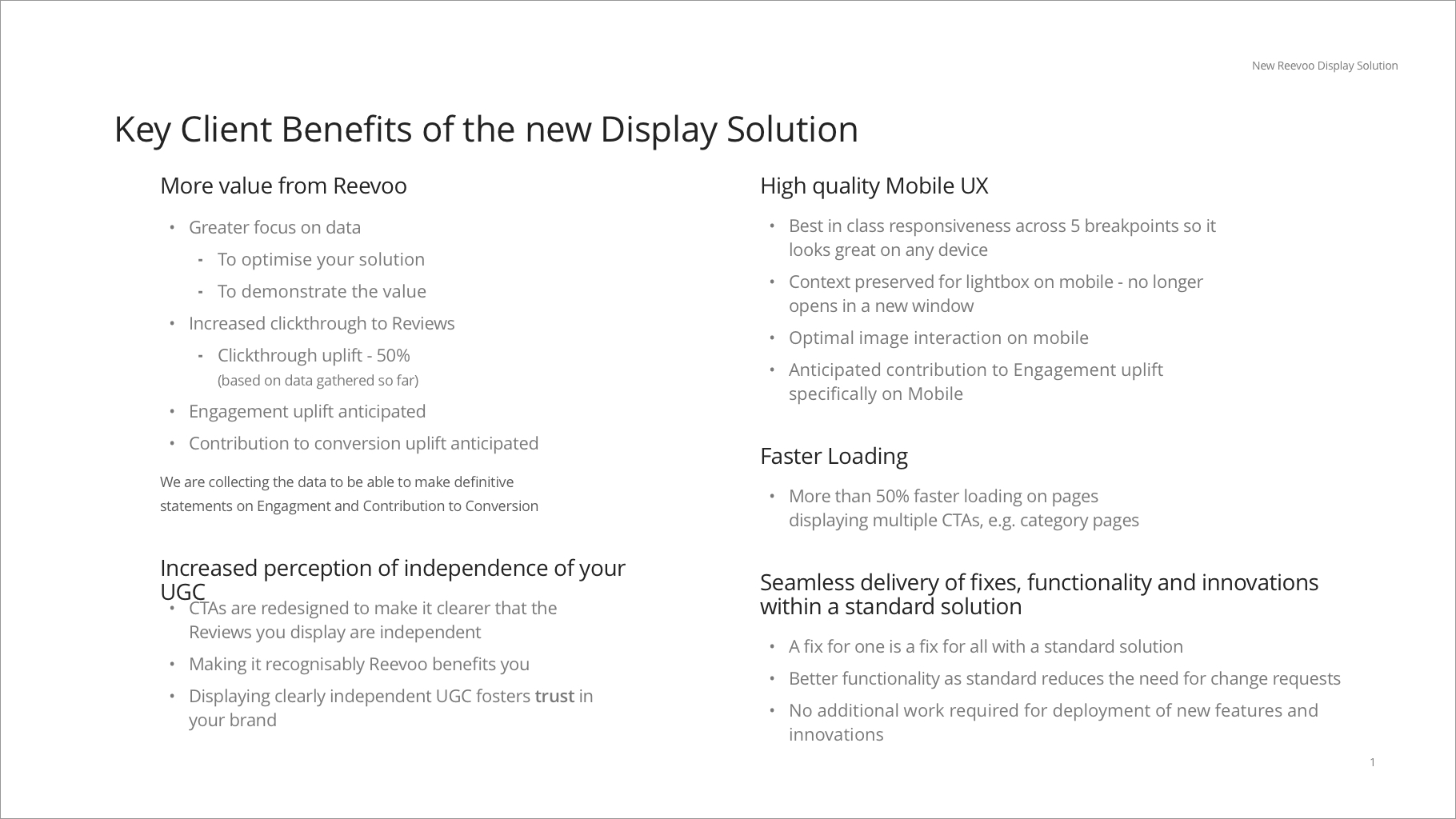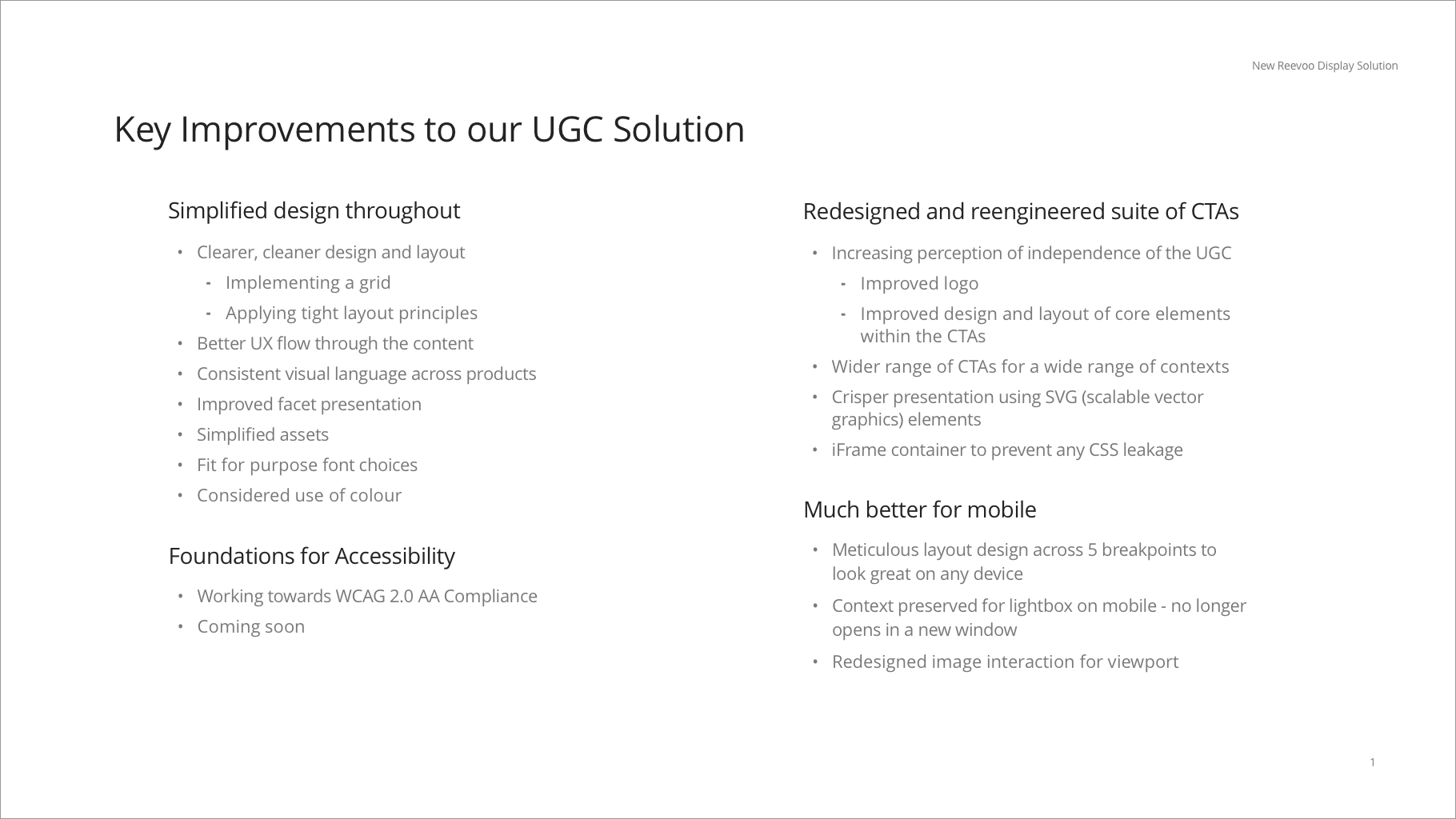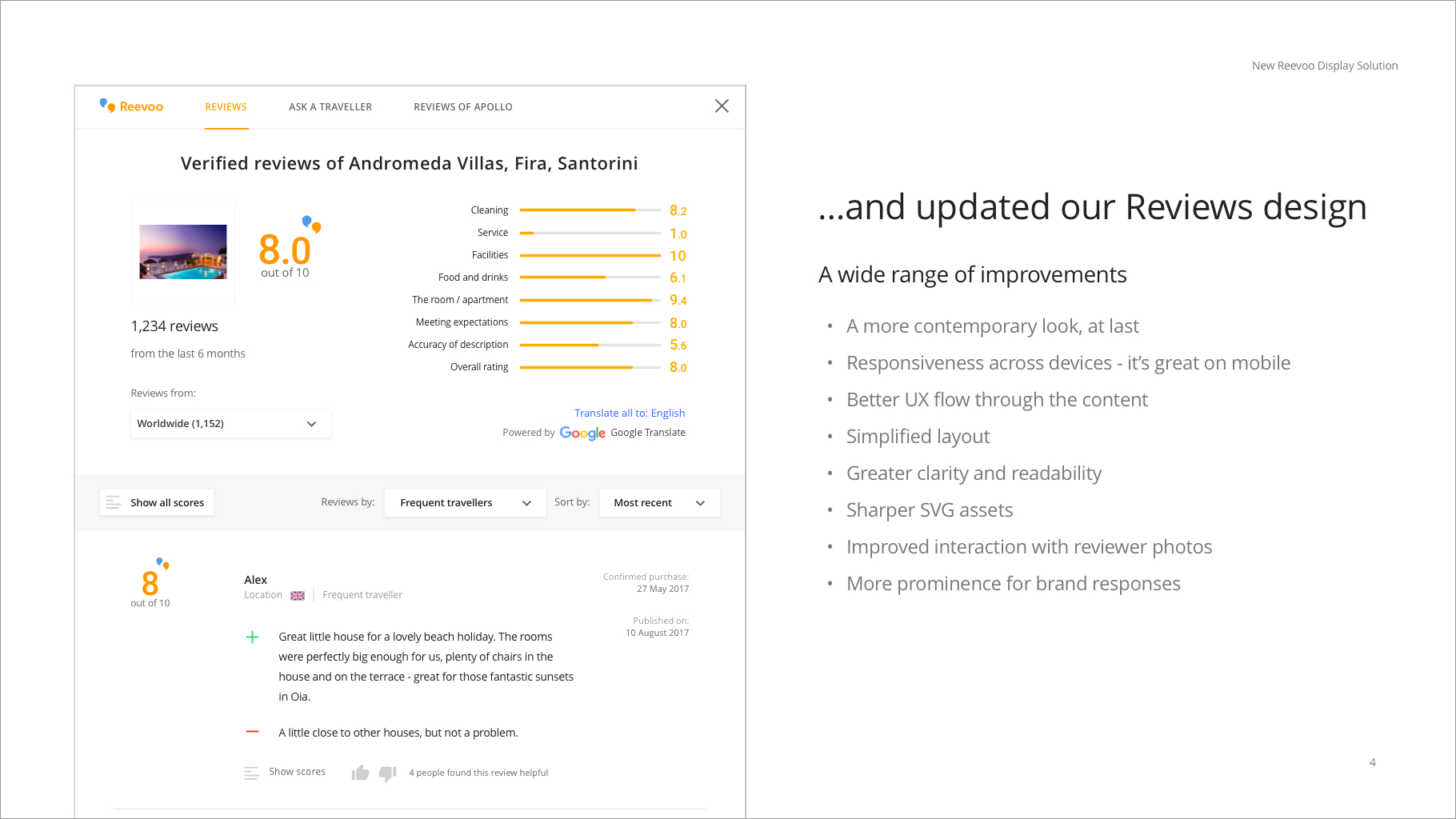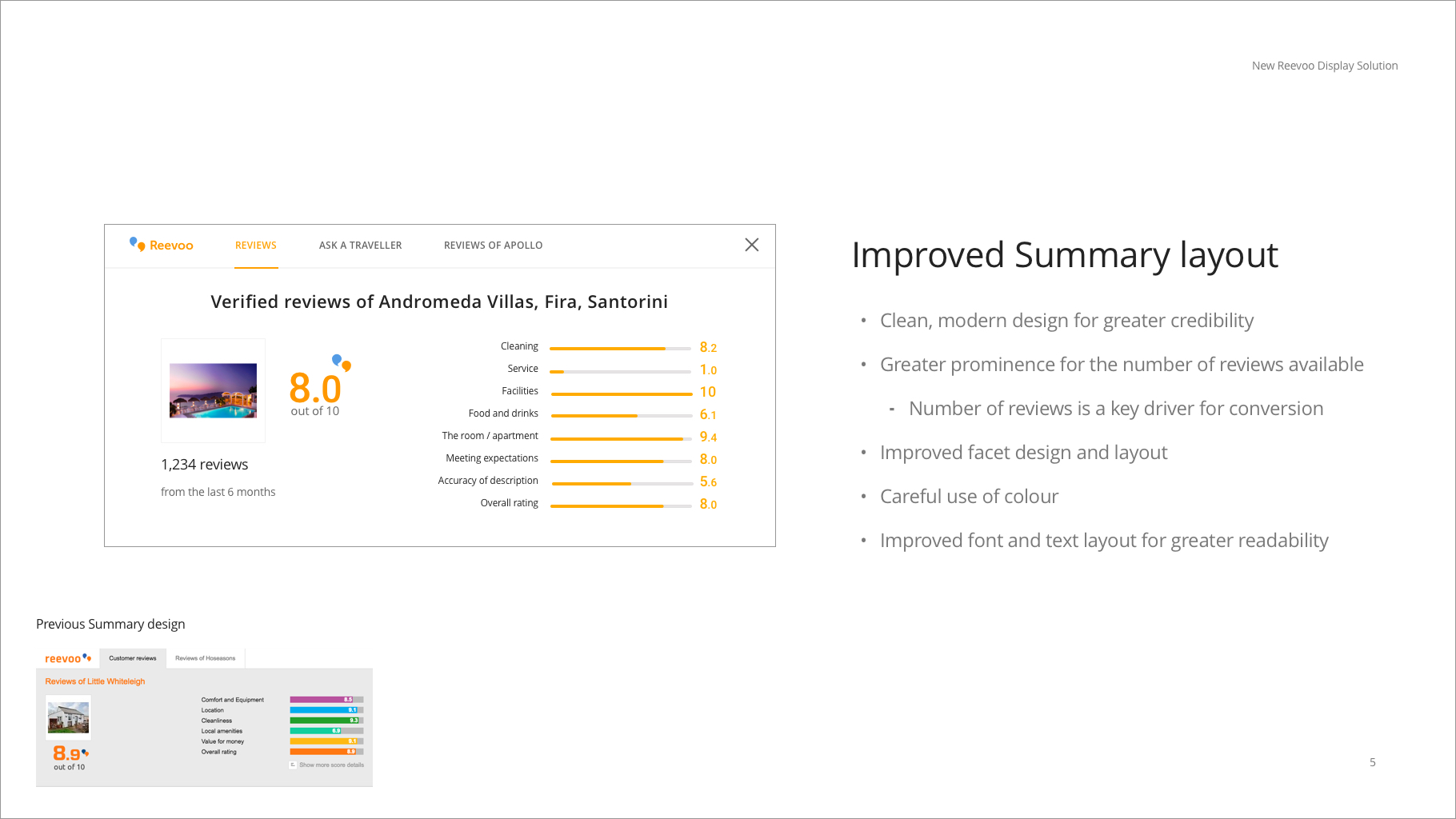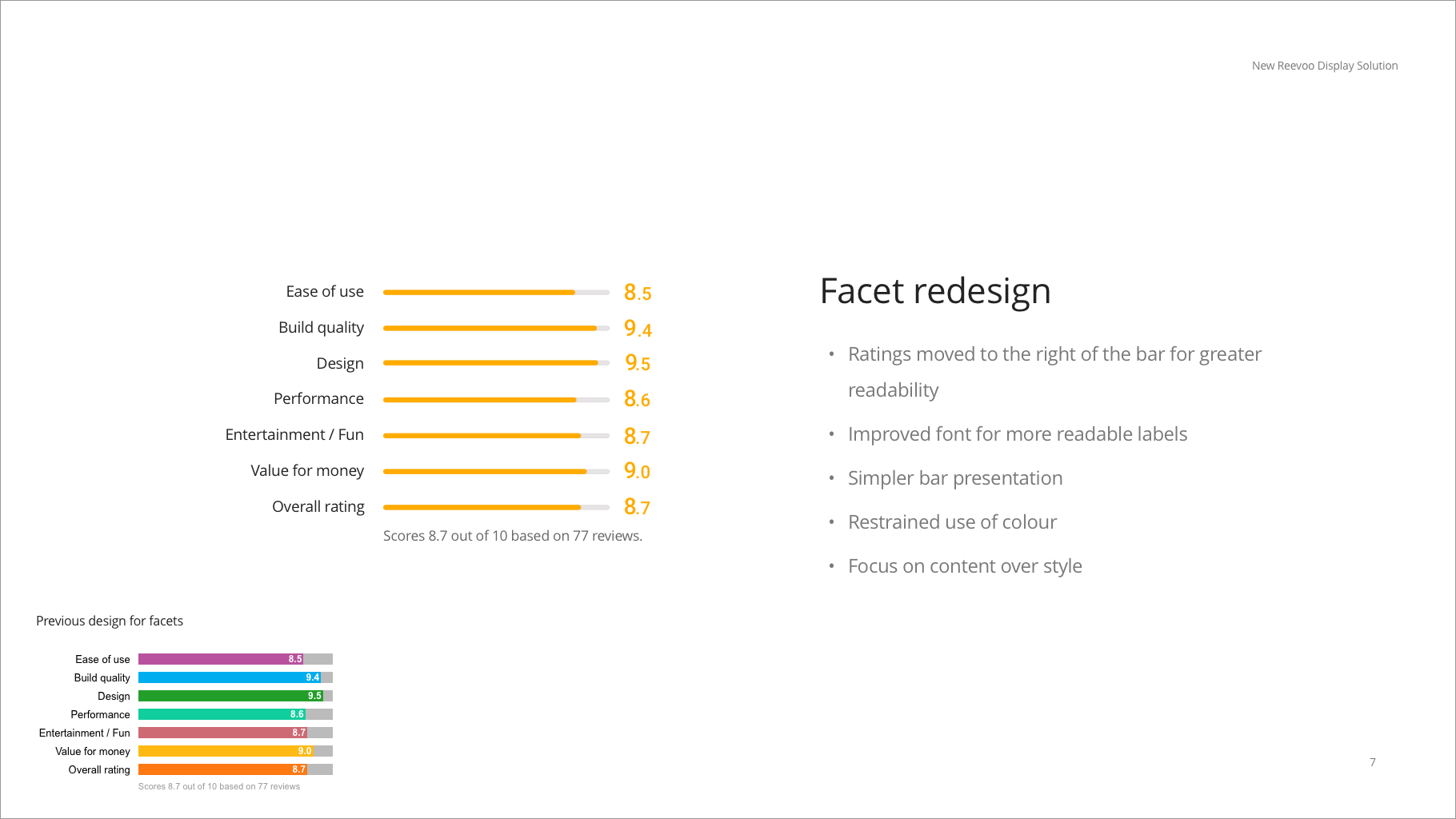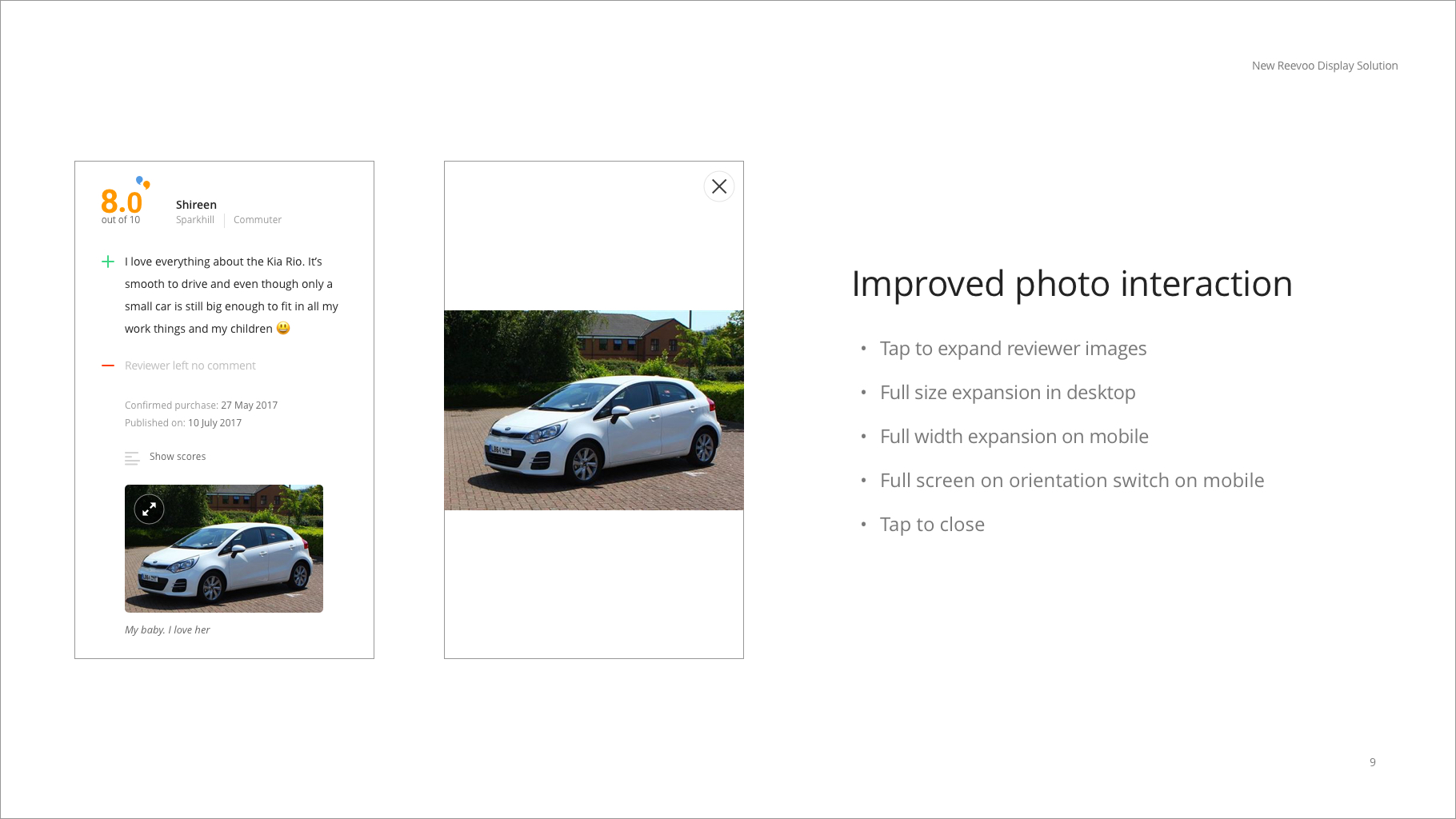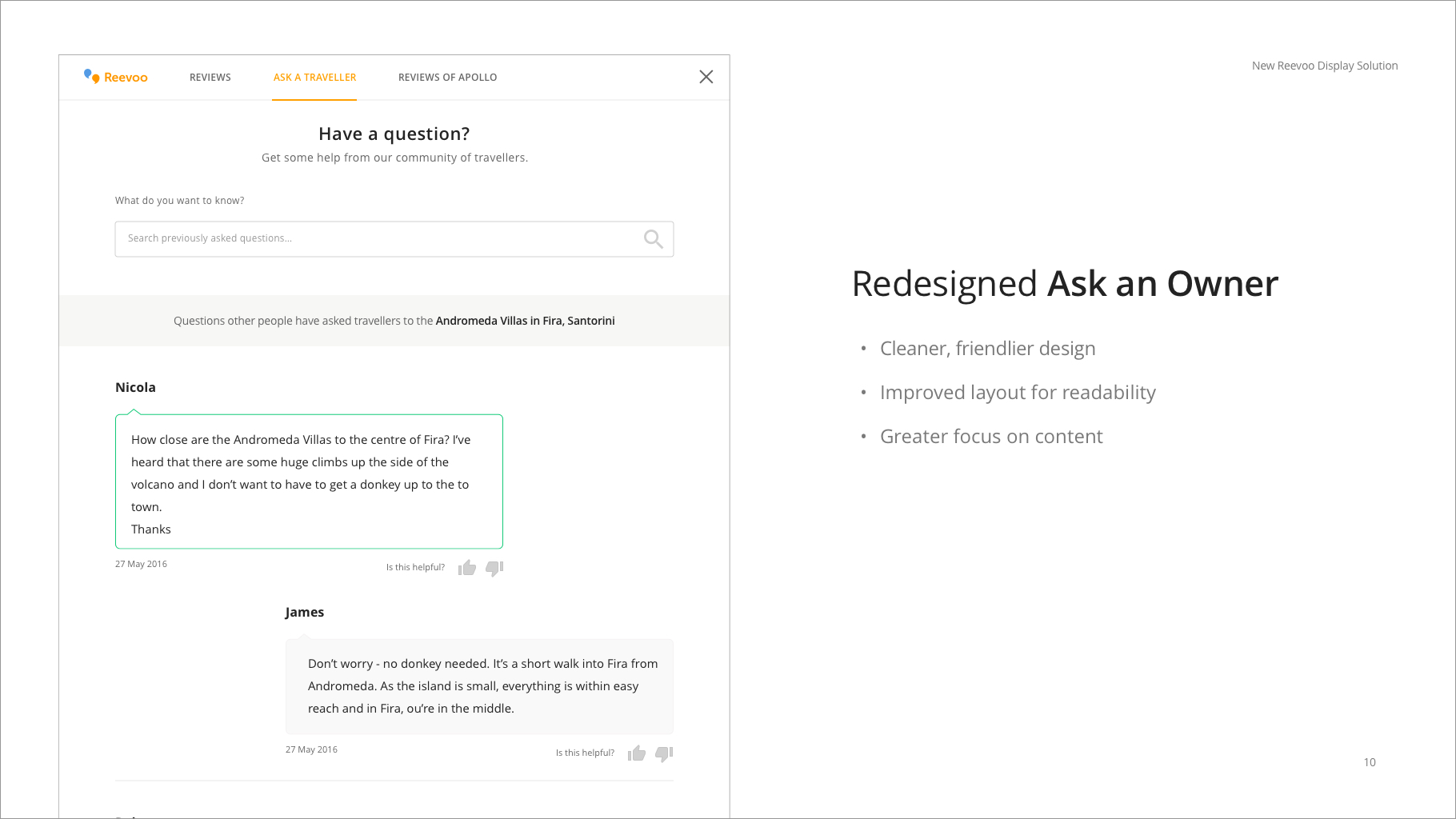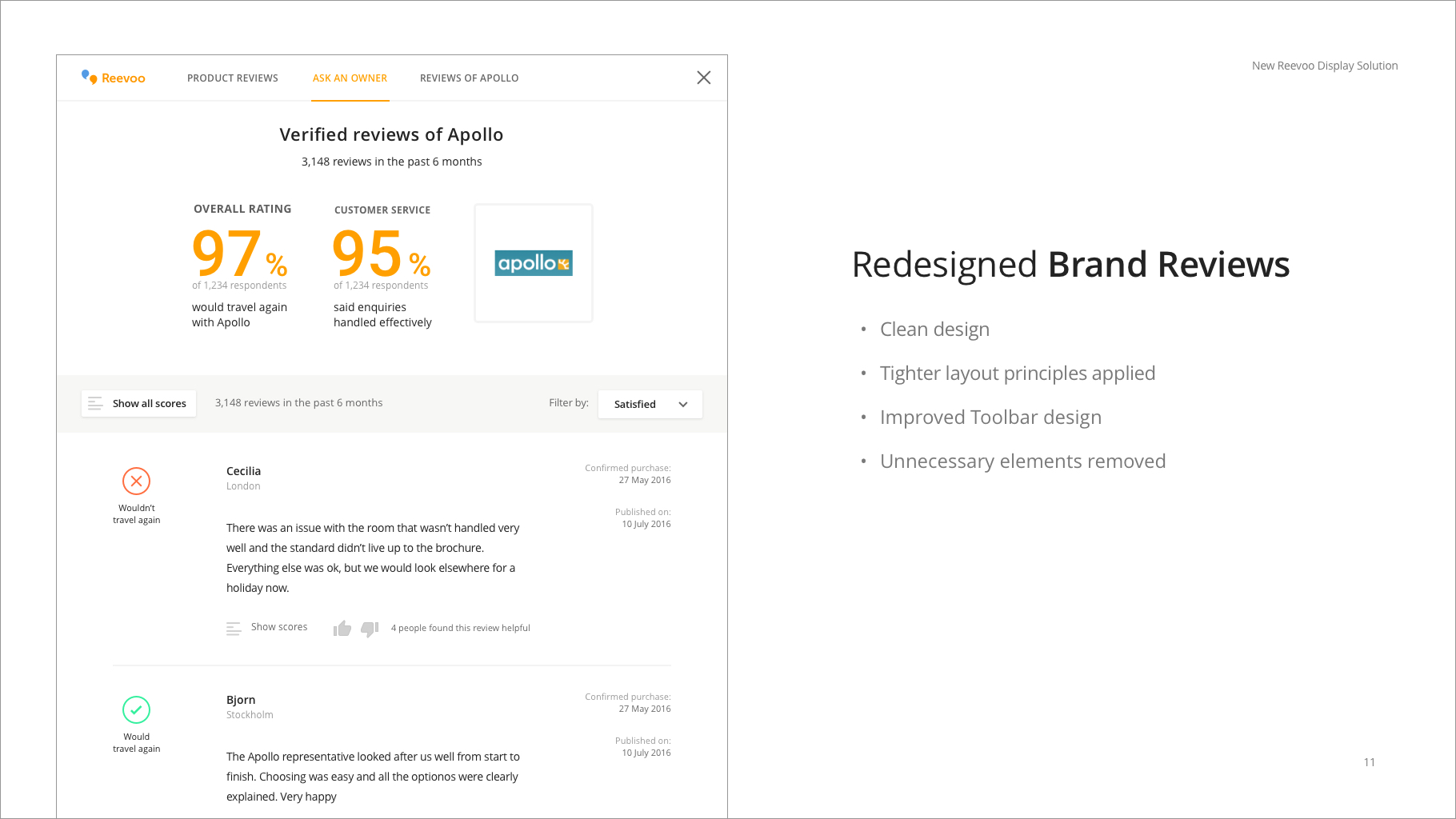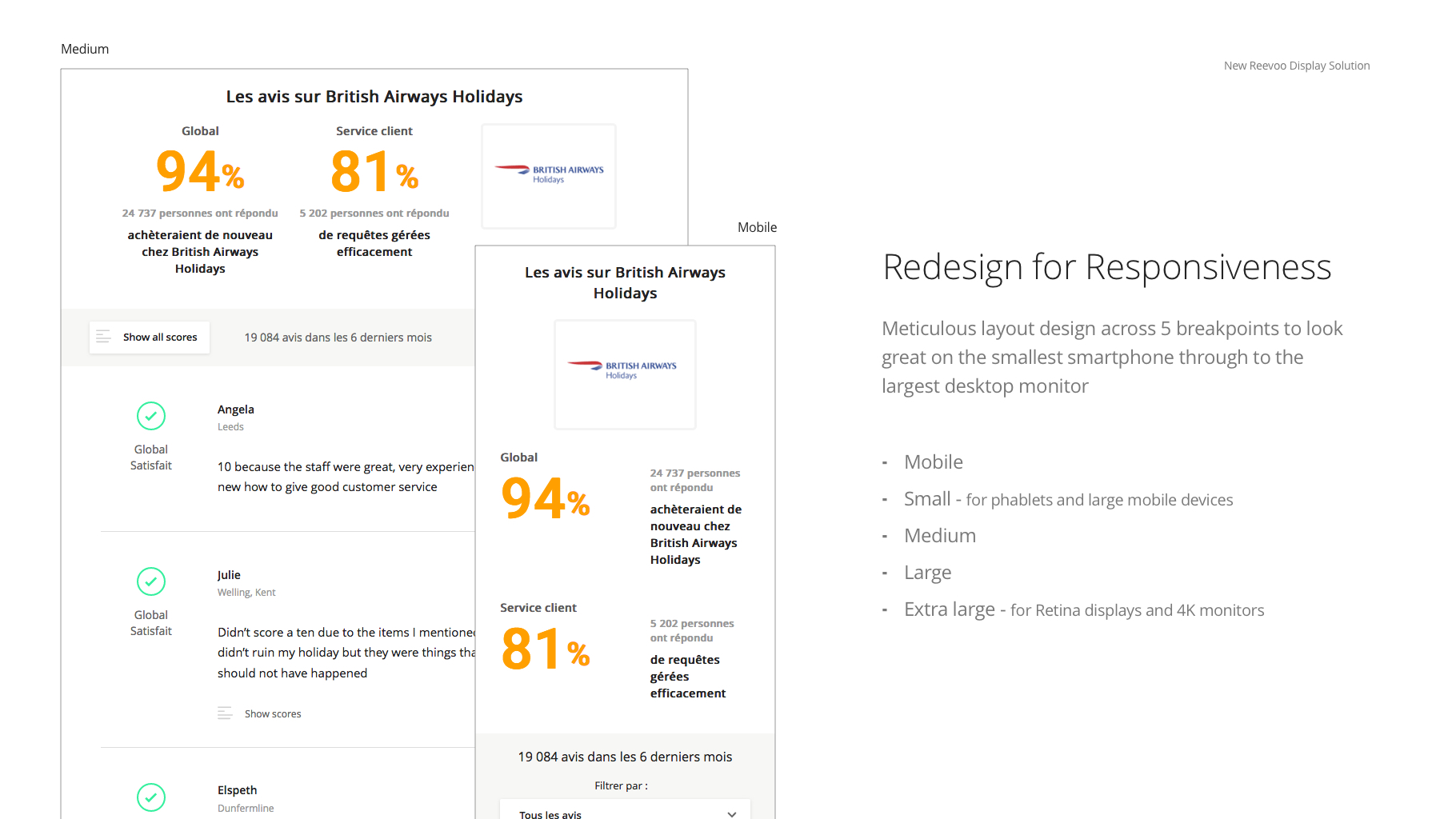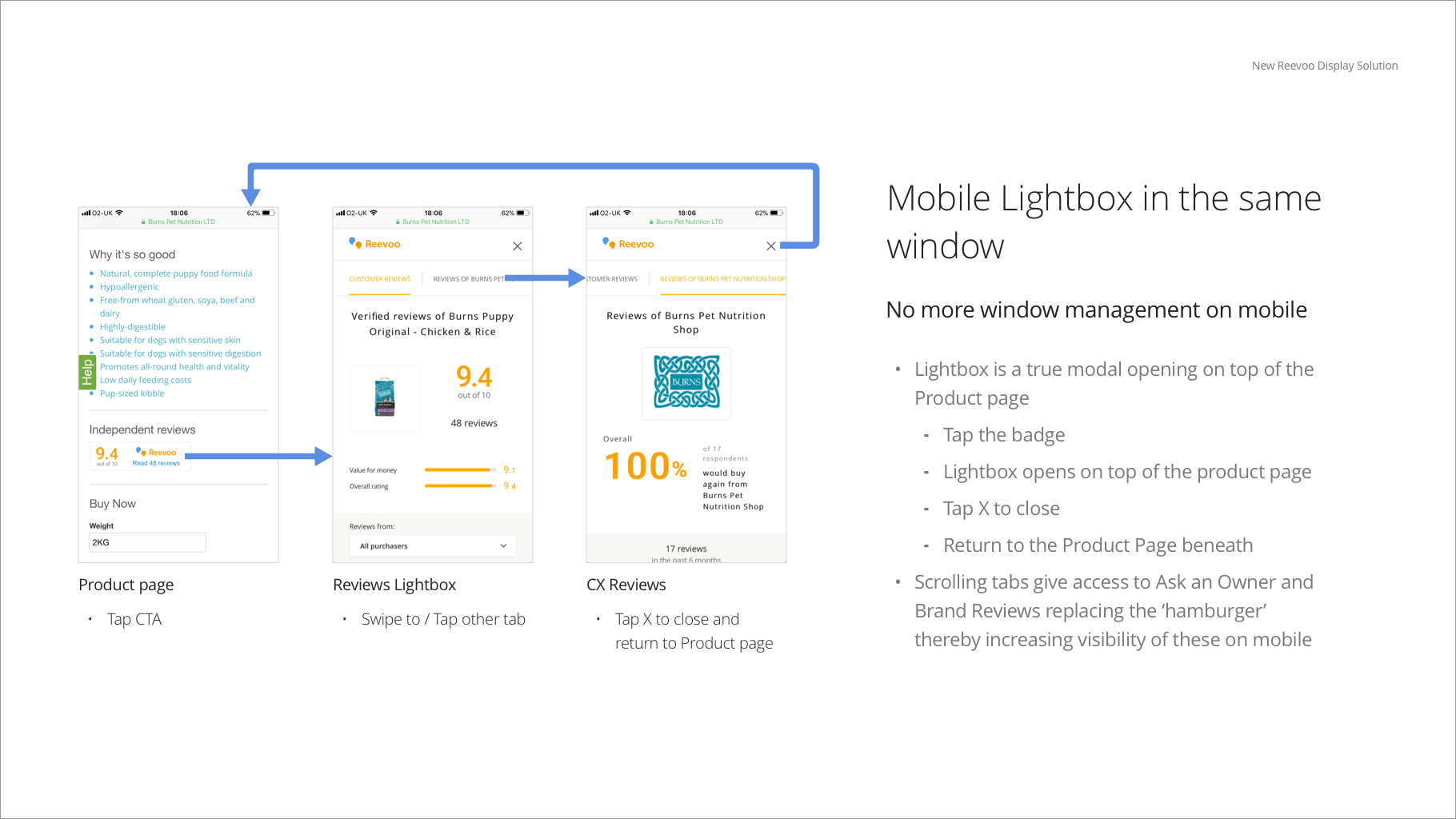New Display Release
Reevoo
Capabilities: UX Design, Team Leadership, Mentoring, Agile, Prototyping, Service Design, Digital Transformation
Tools: Sketch, Invision
Timeline: 2017-18
Overview
Reevoo empowers consumers by providing them with independent and honest reviews of products and services from existing owners online at the point of purchase. Displaying this content delivers value to Reevoo’s clients by driving conversion, increasing time on site and fostering consumer trust in the client and their brand.
Initially intended as a simple rebrand and enhancement of the user experience of Reevoo’s Display products (Reviews, Ask an Owner and CX Reviews), with C Team approval, I grew this project into a digital transformation to build the sustainable and scalable path to market that Reevoo needed for their products, overcoming business process, tooling, product and tech debt barriers. Enormous value was delivered to Reevoo by applying the designer’s toolkit to broader business problems.
The Brief
Reevoo’s display solution for Reviews was out of step with new branding and needed updating. Soon after starting there, the Product Team asked me to ‘Finish off the rebranding of the display solution. Half of it has been done already on the Reevoo shopping site (www.reevoo.com/shopping) and with that and the rebranded CTAs, we can apply it to 70% of our clients sites without them having to do anything at all.’
If only some of that had been true! It turned out it wasn’t just the products that needed refreshing - the way Reevoo delivers service to clients needed to rebuilt.
The Design 1 - the Easy Part
A thorough review identified some obvious design improvements to make in addition to applying the the new branding and colour scheme, notably…
Apply a layout grid
Apply a rationale for use of colour
Increase salience of the number of reviews - known to have a positive effect on conversion if a higher number but not reflected in the design
Improve responsiveness and mobile experience
Freshen up the design
Pairing with a UI Designer, these issues were quickly resolved and a version compliant with WCAG 2.0 Accessibility Guidelines and later, a layout optimised for Arabic were created. Implementation was slower for a number of reasons, agile being one of them - too many discussions around how atomic stories should be. I pitched for designer/developer pairing outside agile to chop through the design improvements, and this significantly reduced development time - 2 weeks for one product instead of the 3 months it took to make the same changes to a sister product. Being poked constantly by a grumpy developer on ‘why do we have to change this?’ was also useful for honing presentation of the design rationale so the pairing was valuable in many ways.
Here’s a before and after of the Reviews product:
Reviews Display - Lightbox - 2010-18
Branding is out of date, the design is very dated and cluttered, the total number of reviews for the product - a key driver of conversion - is relatively hidden, use of colour is poor and text legibility is low in certain areas (Note: Image is shown at 80%).
Reviews Display - Lightbox - 2018 on
The New Display Release was much cleaner and simpler, the total number of reviews was much more prominent to further drive conversion and use of colour was much more judicious. (Note: Image is shown at 80%).
The Real Design Problem
So far so good, but as we tried to identify the 70% of clients this could be rolled out to, I began to discover what the real design problem was. Reevoo had a very short-term focus and had sold a different solution to each client. This created many barriers to delivering service, notably:
Our systems couldn’t reliably report anything about client solutions
There was no way to identify which clients formed part of the fabled 70% or on what basis the 70% claim had been made
Font licensing was inadequate for existing solutions exposing us to legal action
The proposition was well defined but the product offering wasn’t at all - we did not actively define solutions for clients with our products, often leaving it to the client which generated a maintenance burden, onboarding latency and knock-on delays to cash release
The tools and approach used to deliver service baked in fragmentation of the product offering
Each client has been sold a different solution and the resulting variety of implementations meant delivering product improvements to >1 client solution at a time was practically impossible
After a couple of weeks of intensive manual investigation, we went from the Product estimate of being able to update 70% of clients at the flick of a switch to the reality of being able to update 1 single client with the New Display Release. Immensely frustrating on a personal level, it also highlighted the barriers to scalability - a big problem in the context of investor expectations, strengthening competition and having outdated solutions in market.
There were two options:
Run
Try to fix it
I wanted the business to get some ROI from the New Display Release and I saw an opportunity to use the New Display Release as a vehicle to drive the changes so badly needed in Reevoo, so I set about trying to fix it.
The Approach
My strategy for addressing these issues was in 3 parts:
Switch as many existing clients as possible and track performance data for the New Display release to convince those clients who needed to do more on their side to switch
Engage and onboard new clients with defined standard solutions using the New Display Release
Redesign Reevoo service delivery
Switching Clients
Performance data on the New Display Release was critical to getting it rolled out as widely as possible - demonstrated uplift on KPIs after switching would be very persuasive where more work was required from an existing client for them to switch. I defined a process to identify and target clients to switch over, including collection and analysis of performance data, but with performance tracking on many client sites being poorly implemented or not implemented at all, it proved a real challenge to get any reliable data for any KPIs.
Outcome
A much more detailed picture of the nature of what had been delivered to market so far came out of auditing clients. Lack of standardisation of Reevoo solutions had created a lot of product debt, maintenance overhead and increased cost to update. It was unrealistic to upgrade all clients, but several clients could eventually be updated with the New Display Release.
Updated clients enjoyed:
7-10% uplift on the Time on Site KPI
Up to 50% uplift on the Clickthrough to Reviews KPI
The new display release was clearly delivering a lot more value than the previous design. More clients switched over as they updated their websites - we provided them with new standard solutions using the New Display Release. The process of auditing clients and the results also made the business much more interested in generating a better picture of client status and nature of their solutions, putting Account Management and Customer Success teams in a much better position to nurture the relationship.
Engage and Onboard New Clients with the New Display Release
Discovery
I needed to do some discovery work to understand the existing flow for client onboarding and how to fold the New Display Release into it. Stakeholder interviews with internal teams, walkthroughs of our tooling and platform, attending sales pitches and client meetings together generated a lot of ideas on how to do this and improve the flow to compress onboarding timescales, remove duplication of work, improve efficiency and put the client first.
From the discovery work, I identified these key tasks:
Convince Reevoo to invest in designing client solutions upfront by demonstrating the value of doing it
Create high fidelity mockups and demos of solutions, designing the products into client customer journeys
Use them to make it easier for the Sales Team to sell what we have over anything else (e.g. API or custom solution)
Show clients Reevoo on their site so they see the value, see the impact to the site and unite around the solution
Minimise client desire to develop their own solution - it’s already been done by the experts and it looks good
Build knowledge and infrastructure in the business to make this process repeatable and cheap
Give the Solution Delivery team a defined solution to deliver - use mockups and demos as the basis of a solution spec
Make new tooling for creating client solutions, constraining the task to assignment of existing elements instead of forging new elements for the client
Develop a broader set of CTAs - one size did not fit all client contexts
Create a narrative to evangelise this new approach to client engagement with the New Display Release to the business
Create collateral to present the New Display Release and the design rationale internally and to clients
Simple.
Designing Client Solutions
The business needed to productise - to start selling a standard solution, on a single, solid technology foundation. This would be a huge leap forward in the simplicity of delivering service and scalability.
One of the first pieces I worked up was the model of client engagement - central in enabling the business to scale through engaging clients with a defined, standard solution that was simple and cheap for the business to deliver. The model united and contextualised the other pieces and served as a useful communication tool with stakeholders.
Model for Client Engagement with her new Display Release
A key part of the model is the solution design for a client site - analysing the Customer Journey and carefully selecting and placing Reevoo elements within that journey to maximise the value. This was a no-brainer but wasn’t being done at all. The Sales Team had nothing to show clients aside from the proposition and existing implementations in pitches. The client had no visibility of what Reevoo would look like in the context of their site until implementation was done. The Solution Delivery Team had no specified solution to implement. The result was confused, protracted and painful onboarding, duplication of effort, inefficiency and a long wait for the money.
It was obvious that we needed to start delivering solutions rather than problems to our clients. On reviewing materials intended for a client pitch for a major airline that I was to attend, I decided to design a solution and produce some mockups and an Invision demo of it for the meeting the next day. The impact of this was clear - the client got it straight away and accepted the design rationale of our elements and branding wholesale, in spite of them being a very strong international brand. The client took the demo to show internally to evangelise Reevoo and the solution in their organisation. The Sales Team had something tangible to show that was easier to sell - no need to sell an API or custom solution, helping us control the potential cost of the sale. The Solution Delivery Team had a visual specification for implementation.
Here’s an example demo I made for meetings with KIA UK and other KIA locales.
In collaboration with the UI Designer we produced a thorough guide to designing client solutions to make the knowledge accessible to the business. The longer-term goal was to hand over responsibility for designing client solutions to a dedicated Solution Design Team within Operations.
CTAs and Tooling
I redesigned the tooling for CTA implementation for client solutions so it was much easier for Solution Delivery to implement a standard solution. It also simplified the task from one of remaking Reevoo elements every time to simple assignment of the new, standard elements. Solution Delivery didn’t want to redesign the products every time we had a new client, but the tooling required it.
Working with the UI Designer, we enlarged the set of CTAs in the New Display Release to accommodate the full range of contexts in which they would be placed on client sites using the design rationale I developed for them, shown in these slides below:
Communicating the New Way
I put the strategy into a set of slides evangelising the new approach to internal teams - highlighting issues with the existing process and implementations and the effect of these on the business, a clear description of the proposed solution, the rationale for it and expected benefits and how we should apply it. I presented this to the whole business and later took individual teams through it in detail, focusing on areas particularly relevant to them. A cheat sheet summarised the key concepts making them readily available to all staff when communicating with clients. I also presented it to the new C team that came in when the existing team failed to sell the business. It was very well received by the new CEO, COO and CTO.
Here are the slides:
To communicate the New Display Release to clients I created slides highlighting the design improvements, associated benefits and how Reevoo elements fit in with and complement the user journeys on their websites. I presented these in client webinars and meetings. Account Managers were briefed on the content and also shared the slides with clients.
Here are the slides:
Outcome
It's difficult to provide data on the value of designing clients solutions upfront - there are so many variables in completing a sale and you need several end-to-end onboardings to start drawing conclusions. The clarity and continuity brought to the onboarding process by creating solution designs for clients upfront went down very well with Sales, Account Management and Solution Delivery Teams, especially in dealings with clients outside the UK. A day or two of design work saved hours of discussion and negotiation across all 3 teams, simplified implementation and ensured maximal value to our clients. Reevoo was sufficiently bought into the value of solution design for the Design Team to train others in creating solutions and eventually begin interviewing candidates for the Solution Designer position I wrote the job spec for.
The Tooling redesign reduced implementation work on our side from hours to seconds. The general effect on the business of the design response to the problems the business faced - using design thinking to move product and strategy forward and lay the foundations for scaling the business was very motivating and positive.
Redesigning Reevoo Service Delivery
As part of a Customer Centricity initiative early in my time at Reevoo I’d pushed for the business to begin Service Blueprinting. It was clear there we were very inefficient in delivering service and that revenue was the focus of the business more than the clients and their experience of Reevoo. At that time the C Team was more focused on selling the business than on improving. I wasn’t immediately successful, but continued applying design thinking and delivering value where I could, building relationships and sowing seeds.
Service Blueprinting was exactly what the business needed - a ground-up rebuild of the service and how we deliver it, bringing together siloed teams and giving everyone in the business a say and a stake in the definition of the complete client experience with Reevoo.
Outcome
After demonstrating the value of design to the business and building relationships with stakeholders through all of the activities above, the new C team finally approved a Service Blueprinting Programme and got board approval to begin. I planned and created the materials for it, kicking off with an introduction to Service Blueprinting for senior staff. An exercise in the session collected pain points from the team which were mapped into a board spanning the Reevoo Customer Journey with pain points gathered from client surveys and interviews. Pain points were grouped by theme. The aim was to use them as requirements to meet with the the Future State Blueprint.
Here's the Pain Points board including themed client and internal stakeholder input:
Compiled and grouped pain points from internal stakeholders and clients
Before finishing at Reevoo I facilitated the first Current State Blueprinting session with Senior staff. The session walked through the process and product of a Blueprinting session. It was immediately clear how valuable Service Blueprinting would be to the business - very animated discussions were sparked between members of different teams as they got new insight into how their work affected others and how we could do things better and more efficiently.
Sadly all of this came too late for the business. Cashflow problems necessitated headcount reduction and I was let go along with 25% of the staff.

